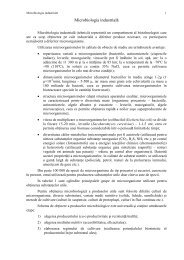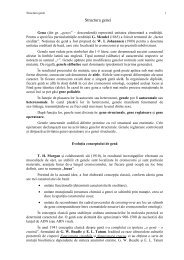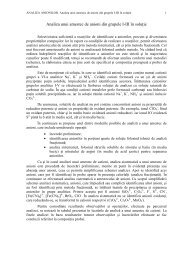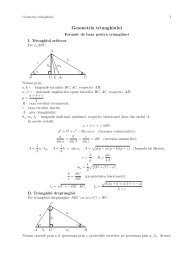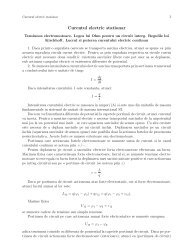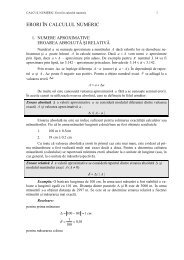Metode de rezolvare a problemelor de calcul la chimia analitica
Metode de rezolvare a problemelor de calcul la chimia analitica
Metode de rezolvare a problemelor de calcul la chimia analitica
You also want an ePaper? Increase the reach of your titles
YUMPU automatically turns print PDFs into web optimized ePapers that Google loves.
<strong>Meto<strong>de</strong></strong> <strong>de</strong> <strong>rezolvare</strong> a <strong>problemelor</strong> <strong>de</strong> <strong>calcul</strong> <strong>la</strong> <strong>chimia</strong> analitică<br />
K<br />
d<br />
+<br />
C(CH 3COONa)<br />
[H ]<br />
= .<br />
C(CH COOH)<br />
Se exprimă [H + ] din expresia matematică obŃinută:<br />
Se logaritmează ecuaŃia obŃinută:<br />
[H + ] =<br />
K<br />
d<br />
3<br />
C(CH 3COOH)<br />
.<br />
C(CH COONa)<br />
lg[H + ] = lg Kd + lg C(CH3COOH) – lg C(CH3COONa).<br />
Deoarece pH = – lg [H + ], schimbăm semnele:<br />
– lg[H + ] = – lg Kd – lg C(CH3COOH) + lg C(CH3COONa).<br />
Astfel am obŃinut formu<strong>la</strong> <strong>de</strong> <strong>calcul</strong> a pH-ului soluŃiei tampon indicate în problemă:<br />
pH = – lg Kd – lg C(CH3COOH) + lg C(CH3COONa).<br />
Se <strong>calcul</strong>ează concentraŃiile acidului rămas în soluŃie şi a sării formate:<br />
Reieşind din consi<strong>de</strong>rentele că alcaliul a interacŃionat completamente şi conform<br />
ecuaŃiei reacŃiei cantitatea <strong>de</strong> acid interacŃionată şi cantitatea <strong>de</strong> sare formată sunt egale cu<br />
cantitatea <strong>de</strong> alcaliu consumat, <strong>calcul</strong>ăm cantitatea <strong>de</strong> acid rămasă şi <strong>de</strong> sare formată:<br />
ν(CH3COOH)exces = ν(CH3COOH)iniŃ. – ν(NaOH) = 1,3168 . 10 -2 – 7,725 . 10 -3 = 5,443 . 10 -3 (mol);<br />
ν(CH3COONa) = ν(NaOH) = 7,725 . 10 -3 (mol);<br />
C(X), mol/ℓ = ν(X), mol/V(soluŃiei), ℓ;<br />
V(soluŃ.), ℓ = V(CH3COONa) + V(NaOH) = 0,037 ℓ+ 0,05 ℓ= 0,087 ℓ;<br />
C(CH3COOH)exces = 5,443 . 10 -3 mol)/0,087 ℓ = 0,0626 mol/ℓ;<br />
C(CH3COONa) = 7,725 . 10 -3 mol/0,087 ℓ = 0,0888 mol/ℓ.<br />
Se <strong>calcul</strong>ează pH-ul soluŃiei:<br />
pH = – lg 1,74 . 10 -5 – lg 0,0626 + lg 0,0888 mol/ℓ = 4,76 –(– 1,20) + (– 1,05) = 4,91.<br />
Problema 7.<br />
Probleme <strong>de</strong> <strong>calcul</strong> <strong>la</strong> capitolul „Echilibre în sisteme eterogene”<br />
Se va precipita oare clorura <strong>de</strong> plumb <strong>la</strong> amestecarea a 40,0 ml <strong>de</strong> soluŃie <strong>de</strong> azotat <strong>de</strong><br />
plumb cu concentraŃia mo<strong>la</strong>ră 1,8 . 10 -3 mol/ℓ şi 30 ml soluŃie <strong>de</strong> clorură <strong>de</strong> magneziu cu<br />
concentraŃia mo<strong>la</strong>ră 3 . 10 -3 mol/ℓ. P.S.(PbCl2) = 1,6 . 10 -5 .<br />
Rezolvare:<br />
Produsul solubilităŃii unui electrolit puŃin solubil reprezintă produsul concentraŃiilor<br />
ionilor în soluŃia saturată a acestui electrolit, ridicate <strong>la</strong> puterile egale cu coeficienŃii<br />
stoechiometrici (pentru simplitate – produsul ionic):<br />
MenAm ↔ nMe m+ + mA n- ;<br />
P.S.( MenAm) = [Me m+ ] n . [A n- ] m .<br />
În soluŃiile nesaturate produsul ionic este mai mic <strong>de</strong>cât produsul solubilităŃii electrolitului în<br />
cauză. Dacă produsul ionic <strong>de</strong>păşeşte produsul solubilităŃii, atunci în soluŃia dată se formează<br />
precipitat.<br />
3<br />
6



